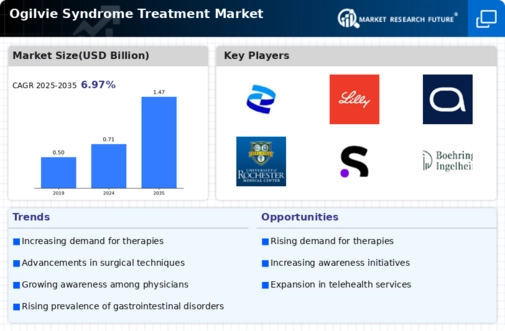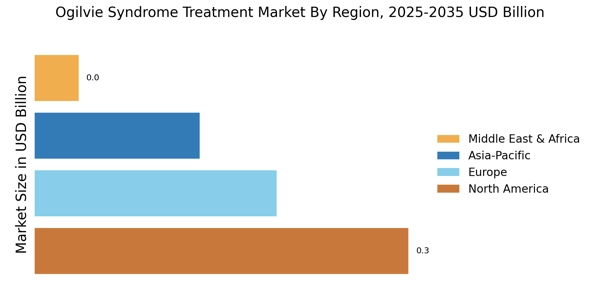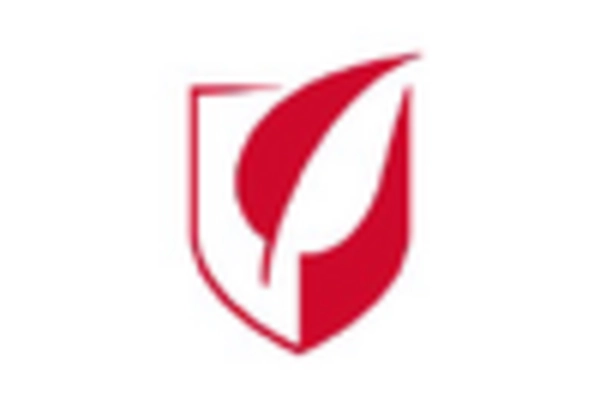Technological Advancements in Treatment
Technological advancements in medical treatments are significantly influencing the Ogilvie Syndrome Treatment Market. Innovations such as minimally invasive surgical techniques and enhanced imaging technologies have improved diagnosis and treatment outcomes for patients suffering from Ogilvie Syndrome. For instance, the introduction of laparoscopic procedures has reduced recovery times and complications associated with traditional surgeries. Furthermore, the integration of telemedicine has facilitated remote consultations, allowing for timely interventions and better management of the syndrome. As these technologies continue to evolve, they are expected to enhance the efficacy of treatments available, thereby attracting more investment and interest in the Ogilvie Syndrome Treatment Market.
Increasing Incidence of Ogilvie Syndrome
The rising incidence of Ogilvie Syndrome is a notable driver for the Ogilvie Syndrome Treatment Market. Recent studies indicate that the condition is becoming more prevalent, particularly among hospitalized patients, with estimates suggesting that it affects approximately 2-3% of patients in acute care settings. This increase in cases necessitates a corresponding rise in treatment options and healthcare resources dedicated to managing the syndrome. As awareness grows among healthcare professionals and patients alike, the demand for effective treatment solutions is likely to escalate. Consequently, pharmaceutical companies and healthcare providers are focusing on developing innovative therapies and management strategies to address this growing need, thereby propelling the Ogilvie Syndrome Treatment Market forward.
Increased Focus on Research and Development
An increased focus on research and development (R&D) within the medical community is a significant driver for the Ogilvie Syndrome Treatment Market. Ongoing studies aim to better understand the pathophysiology of Ogilvie Syndrome and identify novel therapeutic targets. This heightened research activity is likely to lead to the discovery of new treatment options and improved management strategies for patients. Furthermore, collaborations between academic institutions and pharmaceutical companies are fostering innovation in the development of targeted therapies. As R&D efforts continue to expand, the Ogilvie Syndrome Treatment Market is expected to experience a surge in new products and treatment protocols, ultimately enhancing patient care.
Growing Investment in Healthcare Infrastructure
The growing investment in healthcare infrastructure is a critical driver for the Ogilvie Syndrome Treatment Market. Governments and private entities are increasingly allocating resources to enhance healthcare facilities, particularly in regions with high incidences of gastrointestinal disorders. This investment is likely to lead to improved access to diagnostic tools and treatment options for Ogilvie Syndrome. For example, the establishment of specialized gastrointestinal clinics and the expansion of emergency care services can facilitate quicker diagnosis and intervention for affected patients. As healthcare systems become more robust, the Ogilvie Syndrome Treatment Market is poised to benefit from increased patient throughput and enhanced treatment capabilities.
Rising Demand for Non-Invasive Treatment Options
The rising demand for non-invasive treatment options is shaping the Ogilvie Syndrome Treatment Market. Patients and healthcare providers are increasingly favoring treatments that minimize surgical intervention and associated risks. Non-invasive approaches, such as pharmacological therapies and endoscopic procedures, are gaining traction as effective alternatives to traditional surgical methods. This shift in preference is driven by a growing awareness of the potential complications associated with invasive surgeries, as well as the desire for quicker recovery times. As a result, pharmaceutical companies are likely to invest in research and development of new non-invasive treatment modalities, further stimulating growth in the Ogilvie Syndrome Treatment Market.


















Leave a Comment